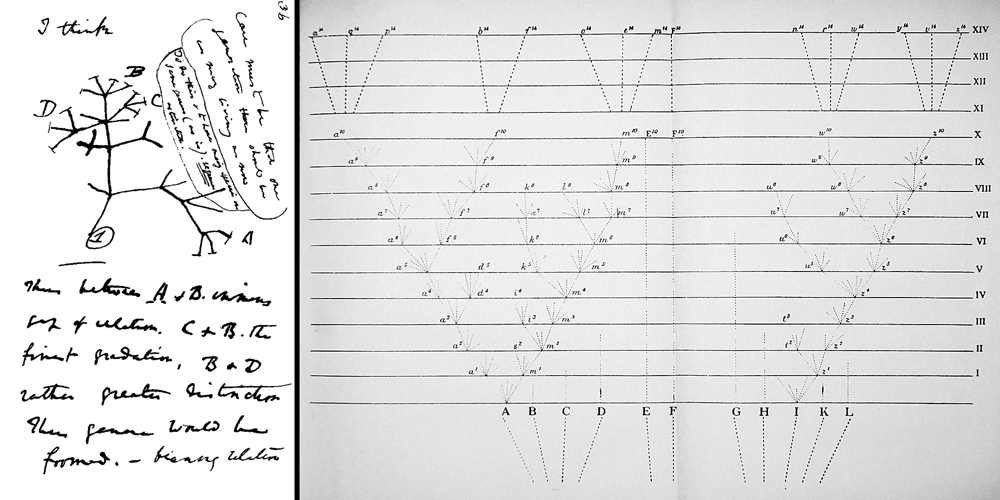Chapter contents:
Systematics
— 1. Taxonomy
— 2. Phylogenetics ←
—— 2.1 Reading trees
—— 2.2 Building trees
—— 2.3 Character mapping
—— 2.4 Phylogenetic trees and classification
Above: A 1837 sketch of a phylogenetic tree in one of Darwin's notebooks. Right: a phylogenetic tree in Darwin's On the Origin of Species, the only figure in the book. Both images are understood to be in the public domain.
Phylogenetic trees are branching diagrams that depict hypotheses of evolutionary relationships between extant and/or extinct organisms. In particular, they depict degrees of relationship among organisms, indicating that certain groups of organisms are more closely related to one another than they are to other groups.
In 1837, Charles Darwin sketched one of the earliest known phylogenetic trees in a notebook, which was followed by another such tree in On the Origin of Species in 1859 (it was the book’s lone figure); these are shown at the top of this page.
The next section in this chapter describes how to read and interpret phylogenetic tree diagrams.
The Cladistic Revolution
Until the 1970’s, most published phylogenetic trees were based on rather subjective data, generally consisting of the “gut feelings” of experts based on their knowledge of the morphologies of particular groups of organisms. This changed during the “cladistic revolution,” which was initiated by German entomologist Willi Hennig (1913-1976). A brief biography of Hennig may be accessed on the webpage of the Willi Hennig Society.

Willi Hennig. Photograph by his son Gerd Hennig (Creative Commons Attribution-Share Alike 3.0 unported license; publication under GFDL allowed).
Hennig developed an evidence-based methodology (termed cladistics) for developing phylogenetic hypotheses. One of his most important insights was that only certain types of characteristics are useful for determining relationships. This approach is outlined in a later section of this chapter.
Uses of Phylogenetic Trees
Biologists and paleontologists do not construct phylogenetic trees simply for the sake of doing so. Instead, trees, or diagram depicting hypotheses of evolutionary relationships among taxa, are constructed in order to help researchers understand evolutionary processes and the histories of particular groups. For example, phylogenetic trees can be used to understand how particular structures evolved and the order in which they appeared (this is described more in a later section). Phylogenetic trees can also be used to investigate the biogeographic histories of groups of plants and animals, or the history of the development of their geographic ranges (for example, see the recent study about spider biogeography by Harrison et al., 2017 in PLoS ONE). Phylogenetic trees are also very useful for developing classifications of organisms that reflect their evolutionary histories and relationships. This topic is further explored in the final section of this chapter.
References
Harrison, S. E., M. S. Harvey, S. J. B. Cooper, A. D. Austin, and M. G. Rix. 2017. Across the Indian Ocean: a remarkable example of trans-oceanic dispersal in an austral mygalomorph spider. PLoS ONE 12(8): e0180139. https://doi.org/10.1371/journal.pone.0180139.
Content usage
Usage of text and images created for DEAL: Text on this page was written by Elizabeth J. Hermsen and Jonathan R. Hendricks. Original written content created by Elizabeth J. Hermsen and Jonathan R. Hendricks for the Digital Encyclopedia of Ancient Life that appears on this page is licensed under a Creative Commons Attribution-NonCommercial-ShareAlike 4.0 International License. Original images created by Jonathan R. Hendricks are also licensed under Creative Commons Attribution-NonCommercial-ShareAlike 4.0 International License.
Content sourced from other websites: Attribution, source webpage, and licensing information or terms of use are indicated for images sourced from other websites in the figure caption below the relevant image. See original sources for further details. Attribution and source webpage are indicated for embedded videos. See original sources for terms of use. Reproduction of an image or video on this page does not imply endorsement by the author, creator, source website, publisher, and/or copyright holder.



